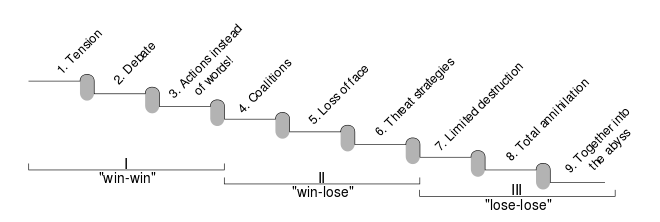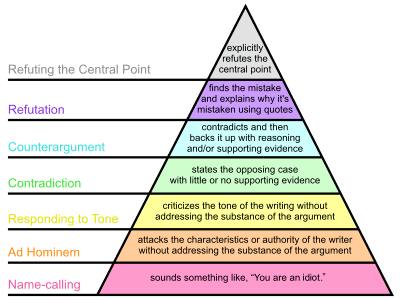De-escalation

De-escalation refers to behavior that is intended to escape escalations of conflicts. It may also refer to approaches in conflict resolution. Escalations of commitment are often hard from spiraling out of proportions without specific measures being taken.
Verbal De-escalation in Psychiatric Settings
De-escalation is aimed at calmly communicating with an agitated client in order to understand, manage and resolve their concerns. Ultimately, these actions should help reduce the client’s agitation and potential for future aggression or violence. An inadequate intervention, or one occurring too late, may leave staff needing to utilize coercive measures to manage an aggressive or violent client. Coercive measures, such as chemical or mechanical restraints and seclusion, are damaging to the therapeutic relationship and harmful to clients and staff.[1][2]
Despite the importance of de-escalation in promoting a non-coercive psychiatric environment, a review of the literature conducted by Mavandadi, Bieling and Madsen (2016)[3] identified only 19 articles that defined or provided a model of de-escalation. Articles converge on a number of themes (i.e. de-escalation should involve safely, calmly and empathetically supporting the client with their concerns). Hankin et al.’s (2011)[4] review of four de-escalation studies reflected the somewhat unclear state of de-escalation research. Their review settled on eight goals, seven elements, 15 general techniques and 15 other techniques divided into three subheadings. Furthermore, a valiant attempt to synthesize the various models and definitions was conducted by Price & Baker (2012).[5] Thematic analysis of 11 eligible studies converged on seven themes: three related to staff skills (e.g. empathetic concern, calm appearance and gentle tone of voice) and four related to the process of intervening (e.g. establish rapport, maintain safety, problem solve and set limits). The available literature provides clinical descriptions of effective de-escalation based on qualitative data and professional observations. However, these thematic analyses need to be supported by more objective data; one hallmark of such objectivity would be an empirical scale or quantitative measure of de-escalation.
English Modified version of the ‘De-Escalating Aggressive Behaviour Scale’ (EMDABS)
1. Valuing the client: Provides genuine acknowledgement that the client’s concerns are valid, important and will be addressed in a meaningful way.
2. Reducing fear: Listens actively to the client and offers genuine empathy while suggesting that the client’s situation has the potential for positive future change.
3. Inquiring about client’s queries and anxiety: Can communicate a thorough understanding of the client’s concerns, and works to uncover the root of the issue.
4. Providing guidance to the client: Suggests multiple ways to the help the client with their current concerns and recommends preventative measures.
5. Working out possible agreements: Takes responsibility for the client’s care and concludes the encounter with an agreed-upon short-term solution and a long-term action plan.
6. Remaining calm: Maintains a calm tone of voice and steady pace that is appropriate to the client’s feelings and behaviour.
7. Risky: Maintains a moderate distance from the client to ensure safety, but does not appear guarded and fearful.
See: Mavandadi, V.; Bieling, P. J.; Madsen, V. (2016-08-01). "Effective ingredients of verbal de-escalation: validating an English modified version of the 'De-Escalating Aggressive Behaviour Scale'". Journal of Psychiatric and Mental Health Nursing. 23 (6-7): 357–368. doi:10.1111/jpm.12310. ISSN 1365-2850
Police
United States of America
Starting around 2015, after facing criticism after numerous high-profile killings of civilians by police officers, some police forces in the US adopted de-escalation training, designed to reduce the risk of confrontations turning violent or deadly for anyone involved.[6][7][8][9][10][11]
In social settings
This often involves techniques such as taking a time-out, and deflecting the conversation to individuals in the group who are less passionately involved. This is commonly used by Fee Team in mental health nursing practice. It is also used as an anger management tool to remove tension between two participants in a conflictual relationship or intervention.
See also
References
- ↑ Duxbury, J. (2002-06-01). "An evaluation of staff and patient views of and strategies employed to manage inpatient aggression and violence on one mental health unit: a pluralistic design". Journal of Psychiatric and Mental Health Nursing. 9 (3): 325–337. doi:10.1046/j.1365-2850.2002.00497.x. ISSN 1365-2850.
- ↑ Huckshorn, Kevin Ann (2006-07-01). "Re-Designing State Mental Health Policy to Prevent the Use of Seclusion and Restraint". Administration and Policy in Mental Health and Mental Health Services Research. 33 (4): 482–491. doi:10.1007/s10488-005-0011-5. ISSN 0894-587X.
- ↑ Mavandadi, V.; Bieling, P. J.; Madsen, V. (2016-08-01). "Effective ingredients of verbal de-escalation: validating an English modified version of the 'De-Escalating Aggressive Behaviour Scale'". Journal of Psychiatric and Mental Health Nursing. 23 (6–7): 357–368. doi:10.1111/jpm.12310. ISSN 1365-2850.
- ↑ Hankin, Cheryl S.; Bronstone, Amy; Koran, Lorrin M. "Agitation in the Inpatient Psychiatric Setting". Journal of Psychiatric Practice. 17 (3): 170–185. doi:10.1097/01.pra.0000398410.21374.7d.
- ↑ Price, Owen; Baker, John (2012-08-01). "Key components of de-escalation techniques: A thematic synthesis". International Journal of Mental Health Nursing. 21 (4): 310–319. doi:10.1111/j.1447-0349.2011.00793.x. ISSN 1447-0349.
- ↑ Apuzzo, Matt (4 May 2015). "Police Rethink Long Tradition on Using Force". Nytimes.com. Retrieved 6 October 2017.
- ↑ "In face of criticism, police officials preaching de-escalation tactics". Usatoday.com. Retrieved 6 October 2017.
- ↑ "Police embrace 'de-escalation' to reduce shootings, but some officers remain skeptical". Latimes.com. 1 October 2016. Retrieved 6 October 2017.
- ↑ Williams, Timothy (27 June 2015). "Long Taught to Use Force, Police Warily Learn to De-escalate". Nytimes.com. Retrieved 6 October 2017.
- ↑ "Police De-Escalation Techniques Validated In New Jersey County". Npr.org. Retrieved 6 October 2017.
- ↑ "Los Angeles Police Institute De-Escalation Policy To Avoid Shootings". Npr.org. Retrieved 6 October 2017.
